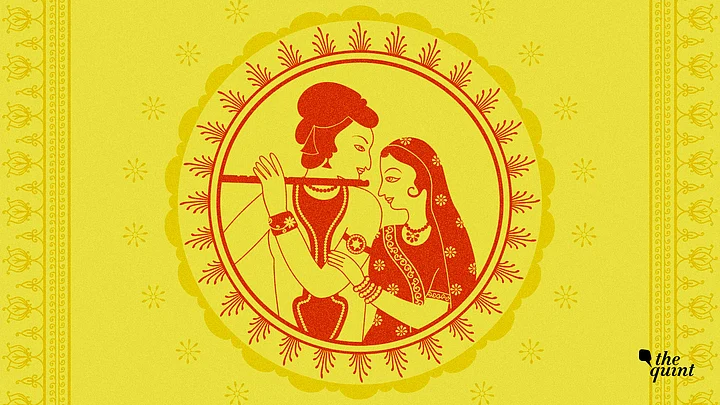How did Radha come to me?
Perhaps it was when I was roaming the narrow lanes of Vrindavana, in search of these elusive mysteries. Amidst the groves of ancient basil bushes stood a room with a bed in it, designed in the style of a government guest house in a minor mofussil town. It had iron shutters through which I could glimpse a postered bed. It was here that they met, those two, in a timeless nocturne, through the yugas, across the ages. The attendant priest handed me a bundle of prasad. The packet he gave me contained some sweet crumbling pedas, fragrant tulsi leaves, a folding mirror, some bindis, glass bangles, a bottle of cheap fluorescent-pink nail polish.
The last three items constituted a traditional ‘suhag ka pitara’, a gift symbolizing the auspicious feminine. It was a moment of illumination. The importance of it, the crucial nuance, came to me in a flash. The mirror was a gateway to the recognition of selfhood. The bangles were a form of armour. I don’t ever wear bindis, but they represent the awakening of the third—the inner—eye.
It was the nail polish that moved me the most, it spoke to me of hopes and yearnings and betrayals, the entire tradition of ‘shringara rasa’, the evocation of the mood of romantic and erotic love from the Natyashastra that is such a deep undercurrent of Indian culture.
***
The figure of Radha was first mentioned in the medieval period, in the exquisite Gita Govinda of the poet Jayadeva of modern-day Odisha, and in the maha-mantra of Radha and Krishna extolled by Nimbakacharya in the 11th and 12th centuries. This anthology carries many perspectives on how the visualization and iconography of ‘Radharani’ evolved, through the Chaitanya school of Vaishnavism, and the philosophical and poetic interpretations of the Bhakti movement. These traditions were continued in the late 15th century in the magnificent poetry of Chandidas of Bengal and Vidyapati of Mithila, and later in the verses of the blind seer Surdas.
***
Be it the continuity of dance traditions in Manipur or the everpopular devotional songs of Meera Bai, interpreted through cinema, Radha lives on in everyday life around us. The emotions invested in her are intense and intuitive. Then there is the intriguing figure of self-admitted spiritual guru Radhe Maa, whose videos from various jagrans have gone viral on the Internet.
Radhe Maa was born Sukhvinder Kaur to a Sikh family in the Gurdaspur district of Punjab. Initiated at the age of twentythree by the Paramhans Dera in Hoshiarpur to become ‘Radhe Maa’, she gained an influential disciple early on, whose family owned a chain of successful sweet shops.
Her clothes, lipstick, the furniture, carpets and curtains, even the ceilings in her bungalow in Borivili, Mumbai, are all painted red, as are the lifts in the building. Her life as a self-proclaimed god-woman and cult leader has been mired in controversy and litigation. Her website and Facebook account reveal a standard sanctimonious tone interspersed with whacky photographs. She looks like a downmarket model, with good skin and an admirable figure for her fifty-plus age group. A ‘hot avatar’, she poses in red miniskirts and boots. She has an eye for the news, and there are photographs of her in a red bikini in circulation.
The Akhil Bharatiya Akhara Parishad, the apex body of Hindu sadhus, has mentioned her on their list of fourteen ‘Fake Spiritual Leaders’. What does Radhe Maa of Borivili have to do with her namesake Radha, the beloved of Krishna, and their pastoral romance?
I pondered this, and I do not know. It is one of the mysteries of Hinduism, where everything becomes the opposite of what it once was. The ignominies of popular culture and social media natter continue to embarrass my online research. An evocative thread describes Radha ‘becoming like a side character of a movie, disappearing after the interval’.
So let me return to stories of long ago, and a tale I encountered in a now-forgotten book, of how Radha, as an aged woman, travelled to Dwarka to meet Krishna.
She was old and tired, and the journey took its toll on her. When they met, the intervening years fell away, and their hearts beat as one. She feasted her eyes, and her spirit, on the divine presence of Krishna, though no words were exchanged between them.
No one in the splendorous city of Dwarka, with its spired roofs and silver domes, knew who the wrinkled woman was, but she was given shelter and a place to stay. One day she set off for the forest. She and Krishna were still one, as they always had been. He followed her and they met, once again, in the dark night, amidst the scented jasmine bushes.
Radha’s time was near, and she was about to leave her body. He asked what she wished of him. ‘Play the flute for me,’ she said. And so Krishna coaxed a divine melody from his wooden flute and dedicated the raga to Radha, the milkmaid of Gokul. As she listened to him, her soul left her body and merged into his. His flute fell silent. Infinitely saddened, yet secure in her presence within him, he broke the flute into two and threw it away. He never played the flute again, but the melody to Radha remained ever in his heart.
(This is an excerpt from Namita Gokhale’s introduction titled ‘The Dream of the Awakened’ in ‘Finding Radha: The Quest For Love’, a collection of essays edited by Malashri Lal and Namita Gokhale, and published by Penguin Random House. The views expressed are the author’s own. The Quint neither endorses nor is responsible for them.)
